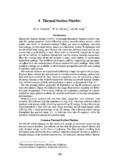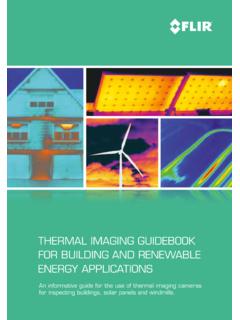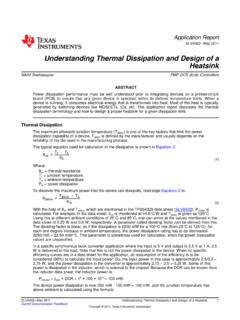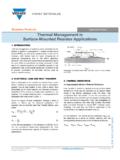Transcription of FREESTUDY HEAT TRANSFER TUTORIAL 2 CONVECTION …
1 (c) D. J. Dunn 1 FREESTUDY heat TRANSFER TUTORIAL 2 CONVECTION AND radiation This is the second TUTORIAL in the series on basic heat TRANSFER theory plus some elements of advanced theory. The tutorials are designed to bring the student to a level where he or she can solve problems ranging from basic level to dealing with practical heat exchangers. On completion of this TUTORIAL the student should be able to do the following. Explain natural and forced CONVECTION . Explain the use of the surface heat TRANSFER coefficient. Explain the use of the overall heat TRANSFER coefficient. Combine CONVECTION and conduction theory to solve problems involving flat, cylindrical and spherical surfaces. Explain the basic theory behind radiated heat TRANSFER . Explain the affect of the emissivity and shape of the surface.
2 Calculate effective surface heat TRANSFER coefficient. Solve basic problems involving CONVECTION and radiation . CONVECTION CONVECTION is the study of heat TRANSFER between a fluid and a solid body. Natural CONVECTION occurs when there is no forced flow of the fluid. Forced CONVECTION occurs when the fluid is forced to flow over the object. Consider a hot vertical surface placed in a cool fluid. The molecules in contact with the surface will receive heat TRANSFER through the process of conduction. The fluid in contact with the surface will become hotter and less dense. If the fluid is a liquid that evaporates, the vapour will be less dense than the liquid. Because the fluid is less dense than the bulk fluid, it will rise and cool fluid will replace it. Natural CONVECTION currents are set up.
3 Clearly the rate of heat TRANSFER depends on the thermal conductivity of the fluid in contact with the surface and the volumetric expansion properties of the fluid. The flow of fluids over a surface is also a major topic in fluid mechanics and the work on boundary layers covered in other tutorials is important for a deep understanding of the topic. When a fluid is in contact with a solid surface, the temperature of the fluid will vary in the region close to the surface. The diagram shows how the temperature might vary in a hot fluid in contact with a cooler solid surface. Clearly if we can make the temperature at the interface greater, the heat TRANSFER will be increased. Consider a hot fluid flowing through a long pipe with heat TRANSFER required into the wall of the pipe.
4 The fluid in contact with the surface will reach the same temperature as the pipe at some point and further contact will not increase the TRANSFER . The heat TRANSFER will decrease with distance as shown. To improve the heat TRANSFER , it is necessary to promote turbulent flow so that the fluid in the core is moved to the edges and comes in contact with the wall. BASIC CONVECTION LAW The heat TRANSFER rate between a fluid and a solid surface by CONVECTION is usually given as = -h A = h A ( h - c ) h is called the surface heat TRANSFER coefficient and has units of W/m2 K. A is the surface area. The thermal resistance is R = 1/hA and this may be used for compound problems. The values of h depend on all the points raised previously and have largely been determined by empirical methods for specific conditions.
5 For example, the value would be different for a flat vertical surface and a flat horizontal surface even if all other conditions are the same. Advanced studies will reveal formulae for finding h under a variety of conditions but at this stage we will simply use the values given. (c) D. J. Dunn 2 WORKED EXAMPLE No. 1 Calculate the heat TRANSFER per square meter between a fluid with a bulk temperature of 66oC with a wall with a surface temperature of 25oC given h = 5 W/m2 K. SOLUTION = h A ( h - c ) = 5 x 1 (66 25) = 205 W COMPOUND LAYERS We can now solve problems involving conduction and CONVECTION . Consider the case of the heat TRANSFER from a hot fluid to cold fluid through a wall made from two layers. We have four thermal resistances. R1 = 1/h1A R2 = t1/k1A R3 = t2/k2A R4 = 1/h2A R = R1 + R2 + R3 + R4 = ( h - c )/R OVERALL heat TRANSFER COEFFICIENT First let s look at the overall heat TRANSFER coefficient for conduction and CONVECTION .
6 Consider heat being convected to a surface, then conducted through a wall and convected to a fluid on the other side. There are three thermal resistances A h12A=R Ak xB=R A h12C=R In terms of the overall heat TRANSFER coefficient = U A In terms of thermal resistance () ++=++=21 CBAh1kxh1 A RRR Equate and A Uh1kxh1 A 21= ++ It is apparent that kxh1h1U121++= This maybe extended to any number of layers in series. (c) D. J. Dunn 3 WORKED EXAMPLE No. 2 Calculate the heat TRANSFER per square meter between a fluid with a bulk temperature of 160oC and another with a bulk temperature of 15oC with a wall between them made of two layers A and B both 50 mm thick. The surface heat TRANSFER coefficient for the hot fluid is 5 W/m2 K and for the cold fluid 3 W/m2 K.
7 The thermal conductivity of layer A is 20 W/m K and for B it is W/m K. Also calculate the overall heat TRANSFER coefficient. SOLUTION For the hot fluid to the wall R1 = 1/h1A = 1/(5 x 1) = K/W For Layer A R2 = t1/ k1A = (20 x 1) = K/W For Layer B R3 = t2/ k2A = ( x 1) = K/W For the wall to the cold fluid R4 = 1/h2A = 1/(3 x 1) = K/W The total thermal resistance is R = + + + = K/W = ( h - c )/R = (160 15)/ = W = U A ( h - c ) U = (1 x 145) = W/m2 K or 222111h1kxkxh1U1+++== +++= U = 1 = W/m2 K SELF ASSESSMENT EXERCISE 1. Calculate the heat TRANSFER through a steel plate with water on one side at 90oC and air on the other at 15oC. The plate has an area of m2 and it is 20 mm thick. The thermal conductivity is 60 W/m K. The surface heat TRANSFER coefficients for the air and water respectively are W/m2 K and W/m2 K.
8 Calculate the heat loss and the overall heat TRANSFER coefficient. (Answer W and x 10-3 W/m2 K) 2. A wall with an area of 25 m2 is made up of four layers. On the inside is plaster 15 mm thick, then there is brick 100 mm thick, then insulation 60 mm thick and finally brick 100 mm thick. The thermal conductivity of plaster is W/m K. The thermal conductivity brick is W/m K The thermal conductivity the insulation is is W/m K The one side of the wall is in contact with air at 22oC and the other with air at -5oC. The surface heat TRANSFER coefficient for both surfaces is W/m2 K. Calculate the heat loss and the overall heat TRANSFER coefficient. (Answer W and 3 x 10-3 W/m2 K) 3. A steam pipe 8m long has an external diameter of 100 mm and it is covered by lagging 50 mm thick. The pipe contains steam at 198 oC and the temperature of the atmosphere surrounding the pipe is 18oC.
9 The thermal conductivity of the lagging is W/m K. The surface heat TRANSFER coefficient is 10 W/m2 K. Assuming the pipe has the same uniform temperature as the steam, calculate the heat loss and the surface temperature of the lagging. (Answer W and ) 4. A spherical tank 2 m diameter contains liquefied fuel gas. It is covered in insulation 120 mm thick with a thermal conductivity of W/m K. The surface heat TRANSFER coefficient between the lagging and the surrounding air is 30 W/m2 K. The air is at 25oC and the liquid is -125oC. Assume the inner surface temperature is the same as the liquid. Calculate the heat TRANSFER rate required to keep the liquid at a constant temperature and surface temperature of the insulation. (Answer 437 W and ) (c) D. J. Dunn 4 radiation A hot body radiates energy in the form of electromagnetic radiation .
10 It is found that the energy radiated depends upon the absolute temperature to the power of 4. A BLACK BODY is one that can absorb all the radiated energy falling on it. A black body will radiate energy according to the law 4TA = is a constant called the Stefan-Boltzmann constant and has a value of x 10-9 W/m2 k4 If two identical black bodies at temperatures T1 and T2 radiate heat to each other, the net heat TRANSFER is )T A(T 4241 = For bodies other than black, the heat radiated depends upon the type of surface and we introduce a property called the emissivity to correct the calculation. )T(TA 4241 = For two identical bodies with different emissivities 1 and 2 it can be shown that 2142411/ 1/ )T(TA + = These equations take no account of the shape and orientation of the bodies with respect to each other and should be used with caution.















